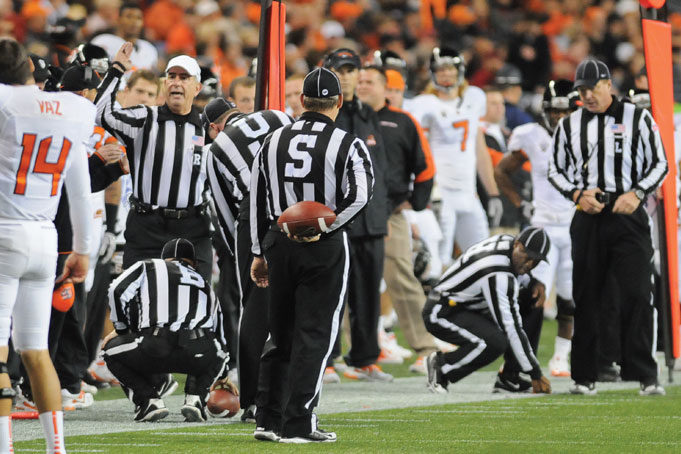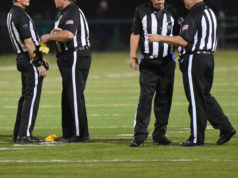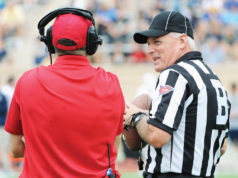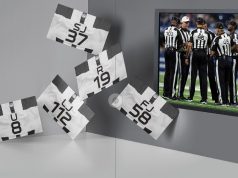One of the oldest sports clichés is that football is “a game of inches.” When a measurement is involved, it might be a fraction of an inch. A football crew may go entire seasons without having to conduct a measurement, particularly with the abundance of turf fields and their perfectly straight lines. But because there are a lot of “moving parts” to measurements, following protocol is crucial.
For ease of reference, in this article, it will be assumed that the linesman is positioned on the chains side of the field and the line judge the opposite side.
Before the game
Inspect the chains before the game. The chain should be taped at its midpoint. If, during the pregame inspection, no tape is found on the chain, ask an athletic trainer or team manager for a strip of tape about six inches long. The chain is folded in half and the tape wound around the links at the halfway mark. The rationale for that will be explained later.
Ensure the stakes are equipped with safe, flat bottoms and check the down box to confirm it operates correctly. Next the chain must be checked for length and integrity and that it is securely attached to the stakes and is free of kinks. Any corrections that are possible should be made.
The linesman may pack a zip tie in his pocket. If a repair is necessary, the zip tie can provide a temporary solution and shorten the delay.
Mechanics
It has become accepted practice for a new series that follows a free kick, punt or turnover to begin on a yardline. That prevents unnecessary measurements. For instance, the kick receiver is downed such that the ball is dead between the 27 and 28 yardlines. The ball should be moved up to the 28 yardline.
Similarly, if a play ends near team B’s 10 yardline and it’s at all possible, place the ball on or just inside team B’s 10 yardline, making it goal to go.
Understand, however, that the above mechanics are used only at the start of a new series following a kick or turnover. At all other times, the spot is the spot.
The wing official on the side of the field opposite the chains is a key cog when the ball becomes dead beyond or close to the line to gain. That official can see the chains and can alert the referee if the ball is clearly short, is clearly beyond the line to gain or is so close he needs to take a look. The linesman should never peek over his shoulder to check the line to gain. Best practice is for the linesman to memorize the line to gain; failing that, observing the line judge will provide the information needed.
The tape on the chain helps determine if team A will achieve a first down on a five-yard penalty, thus precluding the need for a measurement. For instance, if the box is three links behind the tape and team B is flagged for a five-yard penalty, the linesman can check the tape and tell the referee, “They’ll still be short.” Conversely, if the box is slightly beyond the tape, the linesman can place his hand on his chest, which has come to mean “Five will get you one.”
Rules
A measurement may only take place before the ball has been declared ready for play. In NCAA, the referee alone determines if a measurement is necessary. In NFHS, the captain may request a measurement. In either code, there is no measurement if the referee deems it is obvious the line to gain has or has not been reached.
If the ball has become dead close to the line to gain, the covering official should first ensure the clock is stopped and then pinch in all the way to the ball. The retrieving official will hand that official the ball, which will then be placed by the covering official at the dead-ball spot. Directly handing the ball to the spotting official will ensure the ball is not mishandled, resulting in uncertainty in the covering official’s spot.
Procedure
When the referee calls for a measurement, the linesman should have the box moved behind the lead stake. That is a reference point in case the line to gain should somehow become lost during the process. The NFHS manual indicates the down should not be changed on the box; that point is not covered in the college manual.
A beanbag may be placed at the sideline where the chain is clipped. If team A is short, that enables the linesman to go directly to the spot with certainty and is another fail-safe.
As the chains are being brought onto the field, the line judge should use his foot to indicate the intersection of the five yardline where the chain is clipped and a line through the ball parallel to the sideline. That is the spot where the linesman will place the clipped part of the chain.
The linesman brings the chain in from the sideline with the chain crew members. Putting one hand on the links on each side of the clip improves the linesman’s chances of keeping track of the proper link in case the clip falls off the chain. The clip must be placed on the back edge of the line for the measurement. A good double-check is for the linesman to state that the next down will be first if the ball is beyond the stake or the next down of the series if it is short. (Example: “It will either be first or fourth.”)
The back judge holds the ball, positioning himself outside of the forward stake with his back toward the goalline to which the offense is advancing and does not let go of the ball until the measurement is totally finished. In some areas, it is customary for the line judge to step on the chain to prevent any movement when the umpire pulls the stake. Once the linesman tells the referee he has the chain on the proper mark, the umpire takes the forward stake from the chain crew member, then pulls the stake to ensure the chain is taut. The referee makes the determination.
If the measurement is in a side zone and does not result in a first down, the umpire should keep control of the stake. The referee uses his hands (or thumb and index finger if the ball is inches short of the front stake) to indicate how short the play ended of a first down.
The referee grasps the chain at the link in front of the ball and rises. Referee, umpire, line judge and linesman walk to the nearest hashmark. The line judge should have another ball ready to be placed. It’s OK if it’s not the offensive team’s game ball. Once the ball is set and the chains removed, the balls are switched so the offense will snap its own ball.
If the measurement occurred on fourth down and team A is short, the referee signals the change of possession by giving the first down signal toward team A’s goalline. The referee then sets the ball in the same position as it was when it became dead so its foremost point becomes the rear point when the direction is changed. The new rear stake is then moved to the new foremost point of the ball.
If the measurement results in the award of a new series for team A, the referee signals the first down. The linesman need not hold the chain as he accompanies the chain crew back to the sideline, but he must go all the way to the sideline and indicate to the chain crew where the new series will begin.
Regardless of the result of the measurement, the referee must wait for the linesman’s signal that the chain crew is back in position before giving the ready signal.
What's Your Call? Leave a Comment:
Note: This article is archival in nature. Rules, interpretations, mechanics, philosophies and other information may or may not be correct for the current year.
This article is the copyright of ©Referee Enterprises, Inc., and may not be republished in whole or in part online, in print or in any capacity without expressed written permission from Referee. The article is made available for educational use by individuals.



















